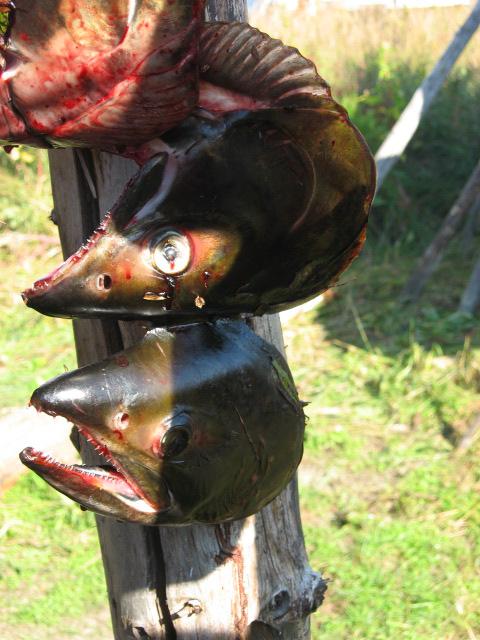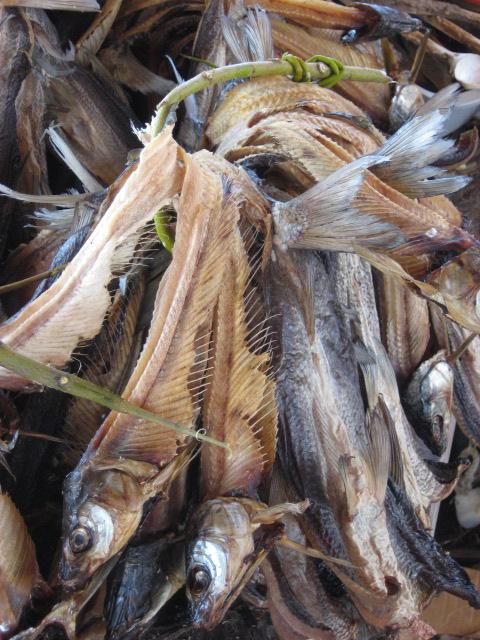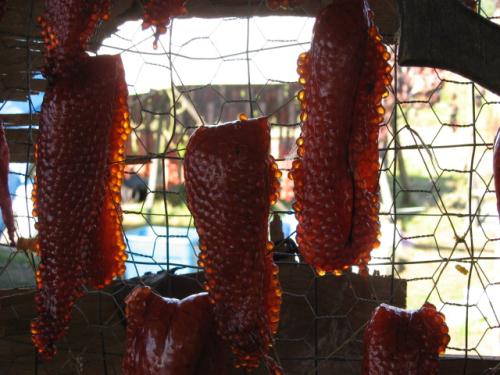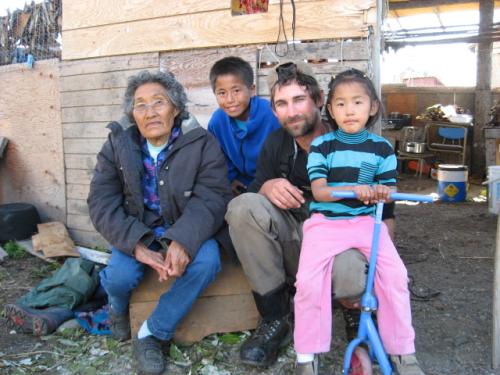We clumsily paddle our raft up to the sandy beach at the edge of Kobuk Village, after 12 days on the river. We’re beat, but happy. Two octogenarian village women amble into a motor skiff off the bank and try to start up the motor. It doesn’t start. We wave. They wave back, then get back to work. Still won’t start. After 5 or 10 minutes, they give up on the motor and inspect the set net at the beach for chum salmon, then pull themselves back in to shore along the float line, and walk back up the steep beach to their drying house, lined with fish. I would much rather go and chat than wash gear, lug gear up the beach and across the village, and fold gear for transportation on a bush plane…but I already have a reputation for being both slow and easily distracted from work, if not outright lazy. So I heave to and start sponging those rafts in order to gain the pleasure of future association with my river comrades.
Halfway to the airport however, I make the acquaintance of Eva, who has just arrived in the village from Anchorage, where she has been finishing up a bachelor’s degree at the University of Alaska. She is curious about such a large group, and we introduce ourselves and talk about our interest in climate change on the Kobuk River. Has she seen any changes on the river? I ask. She pauses for a moment and then says that while there haven’t been noticeable changes in the fish, the river itself seems to be meandering about the valley much more, making it less predictable. She explains that they are used to occasional flooding in town—the village is on an island between two braids of the Kobuk that usually flood in winter. All of the homes are slightly pre-fabbed, many using the same blue shade of exterior pressboard. Perhaps a bulk order. However, all of the homes have been tailored to make concessions to local culture and necessity. For instance, they are all on stilts. People get around in the spring during flood stage on boats, which allow them to visit. Some of the houses are further ornamented with a foyer done up with traditional spruce logs, and the Baptist Church is a grand affair of solid logs, but most have a temporary feel, a sense of practicality suited for winter exigencies, but not for the housing of identity or culture. They are winter shelters.

Eva goes on to say that the increased unpredictability of the river has also manifested in a thermokarst event, resulting in a big hole in the tundra near Ambler, well down river. That and increased meandering has made her current startup business of establishing hunting lodges on the river somewhat difficult. She has been trying to determine four reliable locations. She says she thinks she has appropriate sites picked out and that I should talk to her dad, who has lived in town since he was a boy and fished here the whole time. Unfortunately he is working at the mine right now.

But she says that while I am waiting I should go and talk to Mildred about fish and the process of drying and smoking them. She is down in the drying house now.
When I arrive, I recognize one of the elderly women who were struggling so nonchalantly with the outboard on the beach. She smiles, waves me in. Jacob is already there, and he has brought an entourage of kids with him and a barrage of questions for Mildred, which she is answering. She seems happy to talk about her life and about fish, a passion both she and Jacob without a doubt share.
In the chicken wire coop behind her, chum ovaries packed with sticky eggs are glistening like honey on the drying racks. They sparkle in the sunlight and look like candied grapes. We ask if kids in the village still like to eat them, but she shakes her head wistfully, and says they no longer have a taste for such things. What do they eat instead? She waves her hand: chips, pop. All of these things can be flown in from Fairbanks now. Alaska natives continue to receive large subsidies for flights in and out of the bush, although some pressure exists to end this program. Even so, with the price and scarcity of fuel increasing, I can’t help wondering how long before kids and adults alike find themselves retreating to the older pleasures of “Kobuk Candy”.

Or retreating from the bush altogether. It seems that young people like Eva are the norm, spending more time, especially in winter, in larger cities for work and education; and using the village as a kind of family home for summer visits. Eva explained to me how clumsy she felt in front of Mildred when she tried to split fish for drying. Mildred is clearly an expert. She spent some time showing Jacob the process, and the results are present all around us: expertly split and cleaned whitefish and chum, hanging off racks above a slow smoky fire. Flies obediently and mysteriously stay away from the drying food and cling to a trough full of chum heads and entrails.
On each corner post of the drying racks, are split chum heads, staring totemic like into a very old past, reflecting a form of knowledge and a lifestyle so satisfying that it has persisted for many thousands of years. In the face of changing cultural and economic forces, it still has a tenuous hold on the village life, manifested mostly in elders, and children who come to watch and ask questions and imitate. I ask Mildred if I can take her picture, and she says yes, and I catch Jacob, her and a couple of kids in a fleeting moment of past, present and future running together like river braids.

